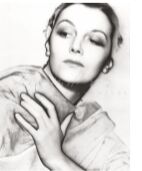
Solarised Portrait (thought to Meret Oppenheimer) Paris, France, 1932
Lee Miller
1907 - 1977
Platinum Palladium Print. 25.6 x 22.7 cm. 28/30.
Om fotografen
Fashion reflects its time and fashion in war is often a response to what is happening. It is also about maintaining a normality under the most difficult conditions. The destruction of war causes everyday situations that lead not only to change but also to renewal in fashion. Lee Miller was a pioneer in fashion photography, moving the shoots from salons and studios into the streets.
Lee Miller was undoubtedly a complex and extraordinary woman. After she died at the age of 70 in 1977, the wife of her son Antony Penrose found a hoard of pictures which Lee Miller had hidden away, repressed and ignored. She was recognised for her work as a war correspondent, photographically witnessing everything from the hell in the Nazi death camps to the liberation of Paris in 1944. In between, her life as a successful model, the muse of Surrealism, and Man Ray’s lover, was frequently in the media.
On the one hand a pragmatic, adventurous seeker of truth. On the other—according to conventional views—a (beautiful) source of inspiration for male artists. But Lee Miller was nobody’s belle, she was an independent, active woman, regardless of what she turned her attention to, be it the terrors of the Second World War or gourmet cooking.
She didn’t say much about her career as a fashion photographer, and neither did anyone else, since portrayals of war outshine narratives of fashion. But nothing impacts on fashion as profoundly as wars. The destruction of war causes everyday situations that lead not only to change but also to renewal in fashion. Fashion is a litmus paper for its own era, revealing everything from social circumstances to ideas about the future.
Lee Miller